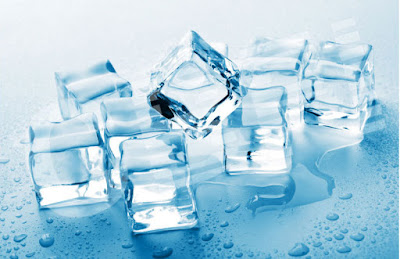Ice can be as badly contaminated with disease-producing germs as polluted water. It was found that freezing does not kill the typhoid bacillus nor many other germs which produce intestinal disease.
Natural ice can be pretty safe if taken from clean lakes and rivers, because it has been proved that ice is purer than the water from which it forms, but if it comes from contaminated waters it is dangerous to use in your drinks or foods.
It is perfectly safe, however, to keep food on it for preservation and refrigeration, provided the food does not come in direct contact with the ice. The food should be well wrapped or in a container. Artificial ice, which is now the kind mostly used in large communities, is safer than natural ice, provided it is manufactured from pure city water or from boiled water.
However, if ice produced from the cleanest water is handled carelessly in dirty containers, or if the clean icecake is dragged over the sidewalk or floor of the restaurant cellar and then brought into contact with food or beverages, it is one of the most dangerous sources of infection by food contamination.
Clean ice cubes which have been cleanly produced and cleanly delivered to your restaurant, but handed over to you by the unclean hands of a waiter are equally as dangerous as ice that has been badly produced.
Just two days ago when visiting a nearby soda fountain I saw a waitress, with not too clean looking hands in the first place, who patted the cat, made change for a few customers, and then picked up a cube of ice and threw it into a customer's glass.
People handling food should have absolutely clean hands, should refrain from handling money or cats unless they wash their hands right after touching any unclean object, and should pick up the ice cubes with a clean spoon or tongs, and deliver them that way into the customer's glass.
Ice cubes made at home in the refrigerator should be made in a clean compartment, in clean trays and handled cleanly as mentioned above. If you are using an icebox, it should be scoured frequently and disinfected with chlorox, and the food should be well wrapped and placed directly on the ice.
Only a short while ago, we here in New York had a Health Commissioner who made it his business to see that food was prepared, distributed, cared for and handled in accordance with the scientific rules of hygiene and sanitation; but his services were quickly dispensed with by high pressure politics under the pretense that he was not scientific enough.
Presumably, a scientific Health Commissioner is supposed to sit high up in his offices and dream scientific dreams, but not go out of his way to apply his scientific knowledge to practical use in protecting the people's health.
ICEBAG
An icebag is very helpful when applied to the head in case of high fever. In such cases the icebag is applied over a cloth napkin placed directly on the head, it should not be allowed to stay on the head longer than five or ten minutes in one place, and should be removed altogether after half an hour, and reapplied again a half hour later if necessary.Over an inflamed appendix you may keep an icebag for much longer periods at a time. Icebag applications to inflamed parts are some times helpful to check the infection and inflammation if used in the early stage before the infection has progressed very far.
An icebag applied to the head is most useful to stop an attack of dizziness. It is also used in stopping a hemorrhage from any part of the body.








0 komentar:
Posting Komentar